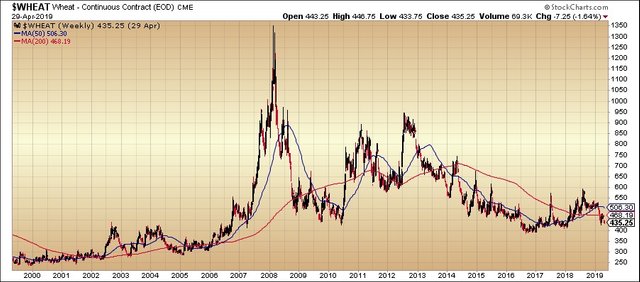Tales Of Wheat, Corn, Golden Cross And Deathcross

(Stockcharts.com Click the picture for higher resolution)
(IPFS Hash)
Someone has given me a tip that I should buy wheat or corn because they are low enough now. In addition, it is quite common for these crops to catch up, make price spikes because of some kind of weather anomaly.
Thinking long term
Undoubtedly, as on the first chart, wheat is currently at a fairly low level of $435, while the 50-day average is $468 and the 200-day average $506. I’m not convinced, though, because it is clear from long-term graphs that at the end of 2016, the wheat exchange rate was at a bottom of ten years. Probably I should have bought it then, in 2016, but not now.

(Stockcharts.com Click the picture for higher resolution)
(IPFS Hash)
The situation with corn is also somewhat similar, with the price of it also being much lower than a few years ago. And spikes are really happening, but not every year. Sometimes, nothing, or the opposite, new lows are coming in summer-autumn. (Overproduction?)
Negative contango yield
The other problem is, like in so many cases by commodities, the contango. Between different corn and wheat settlements (May, July, December at the moment) I calculated contangos between 9.5 and 21 percent on year/year basis. That is a lot if you have to wait a semester or two, you can easily suffer this negative yield.

(Stockcharts.com Click the picture for higher resolution)
(IPFS Hash)
So, I don’t like to buy neither wheat nor corn at the moment but I will monitor them closely. At least I found another interesting sign on the charts: the Death Cross and the Golden Cross. (See definitions below.) On the charts the two seem to be a reliable indicator sometimes that a bull or bear market is about to end. Other times they can be very late or proved to be a false indicator. See the numbers on the last chart:

(Stockcharts.com Click the picture for higher resolution)
(IPFS Hash)
- Years 2001-2002. The 50 days moving average (MA) crosses the 200 days MA from below to above. Golden cross, bullish sign. Continuation? Yes, the bull visited the wheat market in 2002.
- In 2005, the 50 day MA fell below the 200 day MA. Death cross, bearish sign. But the wheat was trading in a channel and in 2006, a strong bullish movement can be observed on the chart.
- In some phase of the price explosion in 2006 mentioned above, the Golden Cross came again. It was right, the bull was very strong, robust.
- Death cross in 2009. The price fell, maybe 25-30 percent, later jumped, and fell again, moving in a roller-coaster. But the next year, in 2010, the price almost doubled. (To 800 from 430 USD appropriately.) Mixed feelings.
- Golden cross in 2011. The price jumped, but more than one year later, middle 2012.
- Death cross at the end of 2013. The price was falling appropriately for 1.5 years at that moment, but after that death cross continued in falling trend three years more.
- Golden cross last year, in 2018. The price continues in falling trend, no bigger sign of turnaround, in my opinion. Not yet.
Chartist analysts may tell you more signs, indicators should be monitored, and they may be right. I prefer my own method: I’m looking for investments on 10-12-15 years low, with some intrinsic value. (My last ideas were coffee in march, and General Electric, last year.)
The death cross is a technical chart pattern indicating the potential for a major selloff. The death cross appears on a chart when a stock’s short-term moving average crosses below its long-term moving average. Typically, the most common moving averages used in this pattern are the 50-day and 200-day moving averages.(Investopedia)
The golden cross is a candlestick pattern that is a bullish signal in which a relatively short-term moving average crosses above a long-term moving average. The golden cross is a bullish breakout pattern (Investopedia)
I really appreciate this effort...
🤪😉😉🤘🤘🤘
Posted using Partiko Android